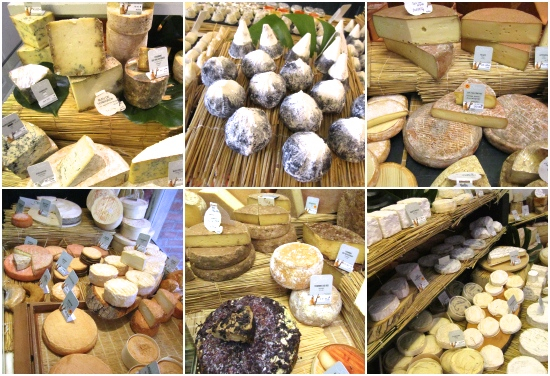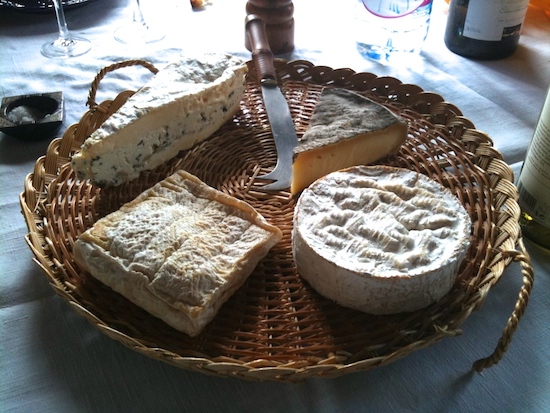Have you ever wondered how to serve a cheese platter? I mean, the way the French do? Okay, so my readers in France are probably rolling their eyes right now, but for a lot of us, it’s not so obvious – hey, we’re even known to serve cheese before a meal – gasp!
I have dinner guests this evening, a few of them from France, and after the meal, I will serve a cheese platter, so I really wanted to get it right.
Earlier on in the week I skyped my mother in-law, Annie, in France to get some advice on how she would do it. Annie is a real foodie and an encyclopaedia when it comes to cooking and produce. She is so passionate about her food that she will travel an hour to a specific farm to choose a young chicken to cook. I’m not kidding. To add to the mix, Georges, her husband, produces grapes for winemakers and owns a boutique wine cellar.
Annie kindly answered the following questions for me:
Annie, where do I start when choosing the cheese?
The first thing is to create a relationship with a good fromagerie. Ask them for advice and choose the cheese for the occasion. The quality of cheese varies depending on the season; it’s much better to have cheese from a sheep or cow that ate fresh green grass, than the winter hay. Ask to taste when possible, and of course, unpasteurised cheese is the key.
What should a good platter contain?
Four to six different cheeses would work well. The platter should be a mix of textures and tastes:
Hard or semi-hard cow’s milk cheese (examples: Comté, Gruyère, Beaufort)
Hard or semi-hard sheep’s milk cheese (examples: Etorki, Pecorino)
Goat’s (young, fresh and crumbly and/or older and buttery)
Blue (cow’s or Roquefort, which is the only blue made from sheep’s milk
Camembert or strong Brie
What should you serve it on?
Any natural material; marble, wood, cane or glass. Stay away from stainless steel or silver as they can alter the taste.
Ensure that you take the platter out of the fridge approximately 1 ½ hours before, to bring to room temperature.
I always feel a little bit confused and intimidated when serving the cheese on my plate. Is there any rule for this?
Absolutely, you should always start with the end in mind. Imagine what serve the last person will have, and ensure that they don’t end up with all of the rind. Serve a slice of each of the cheeses on to your plate.

How to cut and serve the cheese from the platter
Source: Xavier
I have wonderful memories of your father guiding me with the order of consuming the cheese after the meal. Is there really an order to eat the cheese that you’ve served?
Like any food or wine, you should work from the less to more intense. It’s never obvious, at times a goat’s may be stronger than a blue for example. If you’re the host, it’s good to get the order worked out at the fromagerie so that you can lead. If you’re the guest and have no idea, have a small taste of what you’re unsure of and then recommence.
Crackers or Bread?
Bread, good artisan bread!
Georges, what type of wine would you suggest?
If at all possible, get the wine from the same area as the cheese. Red will always work for the entire platter however contrary to common belief, white wine can go very well with particular cheeses.
For a true degustation experience, try the following:
Comté or Emmental with Riesling
Blue such as Roquefort with Gewürztraminer or crisp Muscat
Goat or Sheep’s cheese with some Sauvignon Blanc or Chardonnay
Camembert and Brie only accommodate a red such a full-bodied pinot noir, merlot, cabernet sauvignon.
I’ll also add that I read on the website of one of the top fromageries in France, Xavier, that along with white wine, good quality beer, cider and coffee also work very well with some cheeses!
Thank you so much Annie and Georges for sharing your knowledge and experience with us!
If you’re looking for a fromagerie in Auckland, Sydney or Toulouse (sorry, that’s all I know), I recommend:
Auckland, New Zealand: Maison Vauron – excellent selection and very knowledgeable and I just discovered that Jones the Grocer is in Auckland, if they’re as good as Sydney (see below)…
Sydney, Australia: Simon Johnson and Jones the Grocer. I was always impressed with the knowledge of the staff and cheese rooms of both of these stores.
Toulouse, France: Xavier. Voted “Meilleur Ouvrier de France 2011”, a non direct translation would be the “best artisan in France” – a huge achievement!
Please feel free to recommend in the comments section any great fromagerie that you know in these cities and around the world for our readers (and me)!
Have a great weekend and see you back here on Monday!








Pingback: Armoire, Pegs & Casserole Favourites | Armoire, Pegs and Casserole
Pingback: A French Classic: Daube of Beef | Armoire, Pegs and Casserole
Pingback: Wrapped with Hello Paper | Armoire, Pegs and Casserole
That was a mouth-watering post, Mel.
In Sydney, there is also The Cheese Shop on Military Road, Mosman for a good range, and a knowledgeable owner.
Hi Mel,
I’m french but I’ve never tasted Comte with riesling.. it’s a good idea.. I’ll try and I’ll give your my impression…!
Thanks for your very interesting blog, it’s a pleasure to read your articles..!
bisous à toute la grande famille!
Thanks Mel,
Excellent idea, I love a good Fromage!
Paul x
Hi Mel, where did you take these pictures, they are mouth watering!
I personally buy my cheese from David Jones or from a less known place, the Deli @ Pacific Square in Maroubra Junction, they have a great selection of cheese especially French cheese to accommodate the tatse of the French community who lives nearby! They have other French products too.
Thanks Flo! They are iPhone snaps from a trip to France not in Australia sorry… Yes I’ve heard DJ’s are great for their cheese. Thanks for the other tip at Maroubra:)